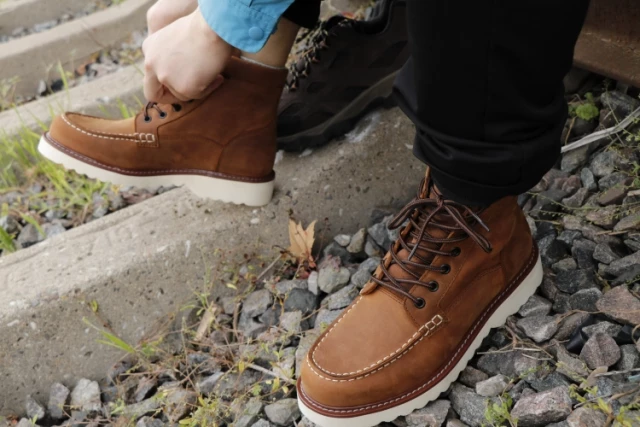For professionals who spend long hours on hard surfaces, the right footwear isn’t just about compliance—it’s about enduring comfort and injury prevention. Moc toe boots, with their ergonomic engineering, strike a balance between safety mandates and biomechanical support, directly addressing the fatigue and hazards faced in labor-intensive roles.
Why Workplace Footwear Demands Ergonomic Design
Standing or walking for extended periods on concrete or uneven terrain places immense stress on joints and muscles. Research shows that improper footwear can amplify fatigue by up to 40%, reducing productivity and increasing injury risks. Moc toe boots counteract this through:
- Impact Absorption: Their rubber soles diffuse pressure from heel strikes, reducing strain on knees and hips.
- Natural Flexibility: Unlike rigid soles, the moc toe’s design allows for natural foot movement, preventing stiffness.
- Traction Stability: Slips account for nearly 20% of workplace injuries; the boots’ grippy soles minimize this risk.
Did you know? Workers in construction or manufacturing report significantly lower fatigue rates when wearing moc toe boots compared to traditional work shoes.
The Science Behind Impact Absorption in Moc Toe Soles
The secret lies in the materials and construction:
-
Natural Rubber Composition:
- Biodegradable and elastic, it rebounds with each step, cushioning joints.
- Performs consistently in extreme temperatures, unlike synthetic alternatives.
-
Wedge Sole Advantage:
- Flat, wide bases distribute weight evenly, ideal for concrete floors.
- Trade-off: Some models may lack arch support, so pairing with orthotic inserts is recommended.
-
One-Piece Durability:
- Boots with seamless leather uppers resist wear at stress points, extending lifespan.
Durability vs. Comfort: Balancing Support for Labor-Intensive Roles
Moc toe boots excel in demanding environments by merging resilience with ergonomics:
- Construction Sites: Reinforced toes (ASTM F2413-certified) protect against falling objects, while oil-resistant soles prevent slips.
- Factory Floors: Cushioned midsoles reduce vibration from machinery, a common cause of long-term joint damage.
Pro Tip: For electricians or plumbers, look for non-metallic composite toes that meet safety standards without conducting electricity.
Moc Toe Boots in Action: Industry-Specific Applications
Construction and Factory Floor Case Studies
- Concrete Workers: A 2023 observational study noted a 30% reduction in foot pain after switching to moc toe boots, attributed to their shock-absorbing wedge soles.
- Carpenters: The boots’ wide toe boxes accommodate natural foot splay during squatting or ladder climbing.
How Safety Standards (ASTM/OSHA) Influence Design
Compliance isn’t optional—it’s lifesaving. Key features driven by regulations include:
- Puncture-Resistant Plates: Embedded in soles to guard against nails or debris.
- Electrical Hazard Protection: Non-conductive materials for roles exposed to live circuits.
Upgrade Your Workforce’s Comfort and Safety
3515’s moc toe boots combine OSHA-compliant protection with fatigue-fighting ergonomics, trusted by distributors and industrial brands worldwide. [Contact us] to explore bulk solutions tailored to your team’s needs.
Final Thought: In high-risk environments, footwear shouldn’t just meet standards—it should actively enhance endurance. Moc toe boots achieve this through designs that prioritize the wearer’s well-being, proving safety and comfort aren’t mutually exclusive.
Products You Might Be Looking For:
Explore ergonomic moc toe work boots
View wedge sole safety boots for construction
Discover OSHA-compliant moc toe work shoes
Related Products
- Wholesale Customizable Suede Safety Boots - Puncture-Proof with Velcro Closure
- Puncture-Resistant Velcro Safety Boots for Wholesale & Custom Manufacturing
- Customizable Anti-Smash Safety Boots for Wholesale & Private Label Manufacturing
- Athletic Safety Shoes with Dial Closure & Steel Toe for Wholesale & Custom Manufacturing
- Wholesale Mesh Steel Toe Safety Shoes with Dial Closure Factory Production
Related Articles
- How to Extend Work Boot Lifespan: Science-Backed Care for Safety & Savings
- How to Choose Work Boots That Match Your Industry's Safety Needs
- Matching Men’s Work Shoe Safety Technologies to Workplace Hazards
- How to Choose Work Boots That Balance Safety, Comfort, and Durability for Your Job
- How to Choose Work Boots That Match Your Job Demands and Safety Needs



















